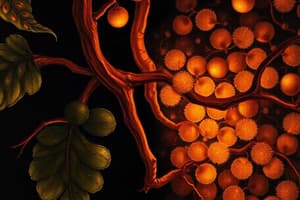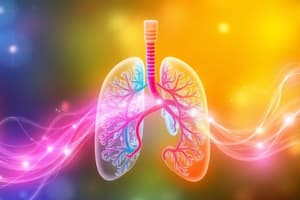Podcast
Questions and Answers
The process of breakdown of food in the cell with the release of energy is called ______ respiration.
The process of breakdown of food in the cell with the release of energy is called ______ respiration.
cellular
When breakdown of glucose occurs with the use of oxygen it is called ______ respiration.
When breakdown of glucose occurs with the use of oxygen it is called ______ respiration.
aerobic
Food can also be broken down, without using oxygen, which is called ______ respiration.
Food can also be broken down, without using oxygen, which is called ______ respiration.
anaerobic
[Blank] are single-celled organisms that respire anaerobically and yield alcohol during this process.
[Blank] are single-celled organisms that respire anaerobically and yield alcohol during this process.
During heavy exercise, ______ respiration takes place in the muscle cells to fulfill the demand of energy causing muscle cramps.
During heavy exercise, ______ respiration takes place in the muscle cells to fulfill the demand of energy causing muscle cramps.
The taking in of air rich in oxygen into the body is called ______.
The taking in of air rich in oxygen into the body is called ______.
Giving out of air rich in carbon dioxide is known as ______.
Giving out of air rich in carbon dioxide is known as ______.
The number of times a person breathes in a minute is termed as the ______ rate.
The number of times a person breathes in a minute is termed as the ______ rate.
When we inhale air, it passes through our nostrils into the ______ cavity.
When we inhale air, it passes through our nostrils into the ______ cavity.
From the nasal cavity, the air reaches our lungs through the ______.
From the nasal cavity, the air reaches our lungs through the ______.
Lungs are present in the ______ cavity.
Lungs are present in the ______ cavity.
The chest cavity is surrounded by ______ on the sides.
The chest cavity is surrounded by ______ on the sides.
A large, muscular sheet called ______ forms the floor of the chest cavity.
A large, muscular sheet called ______ forms the floor of the chest cavity.
Insects have a network of air tubes called ______ for gas exchange.
Insects have a network of air tubes called ______ for gas exchange.
Oxygen rich air rushes through ______ into the tracheal tubes, diffuses into the body tissue, and reaches every cell of the body in insects.
Oxygen rich air rushes through ______ into the tracheal tubes, diffuses into the body tissue, and reaches every cell of the body in insects.
Earthworms breathe through their ______.
Earthworms breathe through their ______.
Frogs have a pair of lungs like human beings; however, they can also breathe through their ______.
Frogs have a pair of lungs like human beings; however, they can also breathe through their ______.
The leaves of the plants have tiny pores called ______ for exchange of oxygen and carbon dioxide.
The leaves of the plants have tiny pores called ______ for exchange of oxygen and carbon dioxide.
Like all other living cells of the plants, the root cells also need oxygen to generate energy take up air from by ______.
Like all other living cells of the plants, the root cells also need oxygen to generate energy take up air from by ______.
Leaves have tiny pores called ______ through which they exchange gases.
Leaves have tiny pores called ______ through which they exchange gases.
Flashcards
Cellular respiration
Cellular respiration
The process of breaking down food in the cell with the release of energy.
Aerobic respiration
Aerobic respiration
The breakdown of glucose using oxygen, producing carbon dioxide and water.
Anaerobic respiration
Anaerobic respiration
The breakdown of glucose without using oxygen.
Yeasts
Yeasts
Signup and view all the flashcards
Inhalation
Inhalation
Signup and view all the flashcards
Exhalation
Exhalation
Signup and view all the flashcards
Breathing rate
Breathing rate
Signup and view all the flashcards
Nasal Cavity
Nasal Cavity
Signup and view all the flashcards
Chest cavity
Chest cavity
Signup and view all the flashcards
Diaphragm
Diaphragm
Signup and view all the flashcards
Spiracles
Spiracles
Signup and view all the flashcards
Tracheae
Tracheae
Signup and view all the flashcards
Gills
Gills
Signup and view all the flashcards
Stomata
Stomata
Signup and view all the flashcards
Study Notes
- Organisms respire to obtain energy from food.
- Breathing involves inhaling air containing oxygen and exhaling air rich in carbon dioxide.
- Air breathed in is transported to all parts of the body and to each cell.
- Oxygen aids in the breakdown of food in cells in a process called cellular respiration.
- Cellular respiration occurs in the cells of all organisms.
Types of Respiration
- During cellular respiration, glucose breaks down into carbon dioxide and water using oxygen.
- Aerobic respiration happens when glucose breaks down with the use of oxygen.
- Anaerobic respiration happens when food breaks down without using oxygen.
- Both aerobic and anaerobic respiration releases energy.
- Yeasts are single-celled organisms that respire anaerobically, producing alcohol.
- Anaerobes are organisms like yeast which can survive without air.
- Muscle cells respire anaerobically for a short time when there is a temporary lack of oxygen.
- During heavy exercise, anaerobic respiration in muscle cells produces lactic acid, leading to muscle cramps.
- Cramps can be relieved by hot water baths or massages.
- These increase blood circulation and oxygen supply to muscle cells, breaking down lactic acid.
Breathing
- Breathing involves inhaling oxygen-rich air and exhaling carbon dioxide-rich air.
- Inhalation is taking air rich in oxygen and exhalation is giving out air loaded with carbon dioxide.
- Breathing is a continuous process.
- Breathing rate is the number of breaths per minute.
- A breath includes one inhalation and one exhalation.
- An adult human breathes 15-18 times per minute when resting and breathing rate increases up to 25 times per minutes during heavy exercise.
- During exercise the body needs more energy, breathing faster supplies more oxygen to the cells for energy production.
- Air normally enters the nostrils, passes through the nasal cavity, and reaches the lungs via the windpipe.
- The chest cavity which holds the lungs is surrounded by ribs and has a diaphragm as its floor.
- Rib cage and diaphragm movement facilitates breathing.
- During inhalation, ribs move up and outwards and diaphragm moves down.
- During exhalation, ribs move downwards and inwards and diaphragm moves up to its former position.
- Sneezing expels foreign particles from inhaled air.
- It's vital covering the nose while sneezing to prevent spreading foreign particles.
- Smoking damages lungs and is linked to cancer, smoking is best avoided.
Breathing Out
- Air exhaled is a mixture of gases, not just carbon dioxide.
Other Animals Breathing
- Animals like elephants, lions, cows, goats, frogs, lizards, snakes, and birds have lungs.
- Cockroaches have spiracles and tracheae for gas exchange.
- Earthworms breathe through their moist skin.
- Frogs use both lungs and their skin for breathing.
- Aquatic animals like fish have gills to utilize dissolved oxygen in water.
- Gills are projections of the skin supplied with blood vessels for gas exchange.
Respiration in plants
- Plants respire like other living organisms.
- Each part of a plant can independently take in oxygen and give out carbon dioxide.
- Tiny pores called stomata on leaves exchange oxygen and carbon dioxide.
- Root cells take up air from air spaces between soil particulars.
Studying That Suits You
Use AI to generate personalized quizzes and flashcards to suit your learning preferences.




